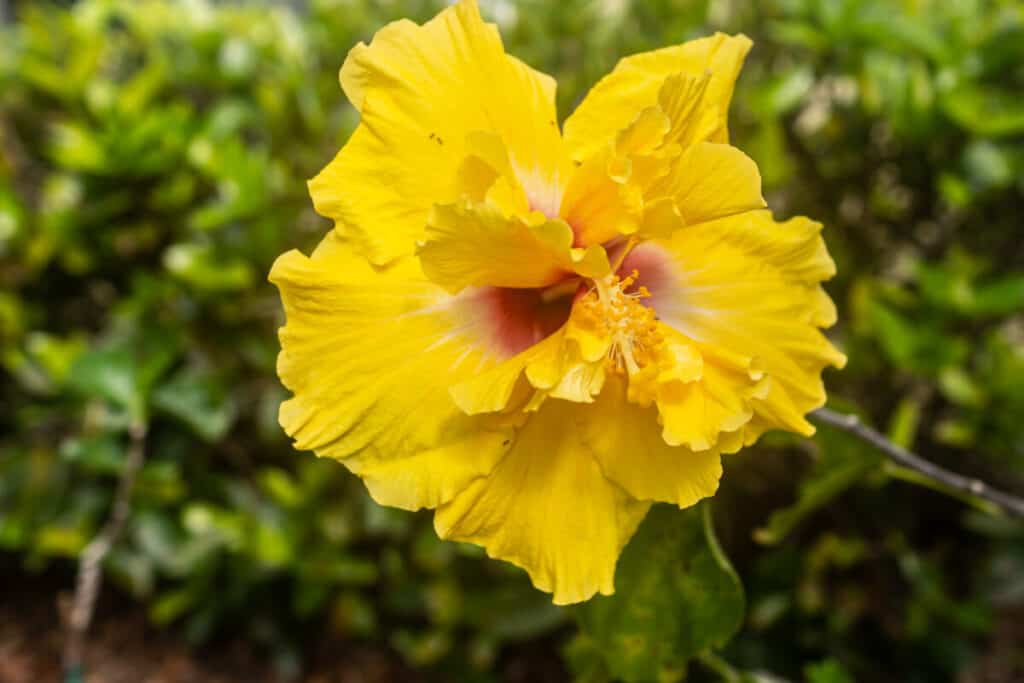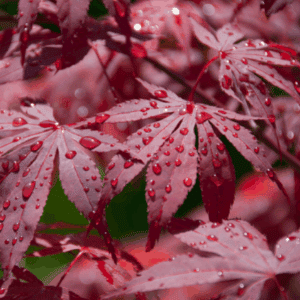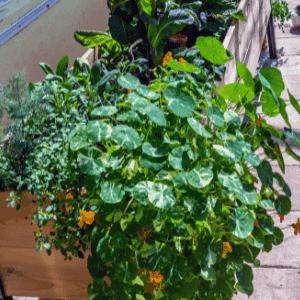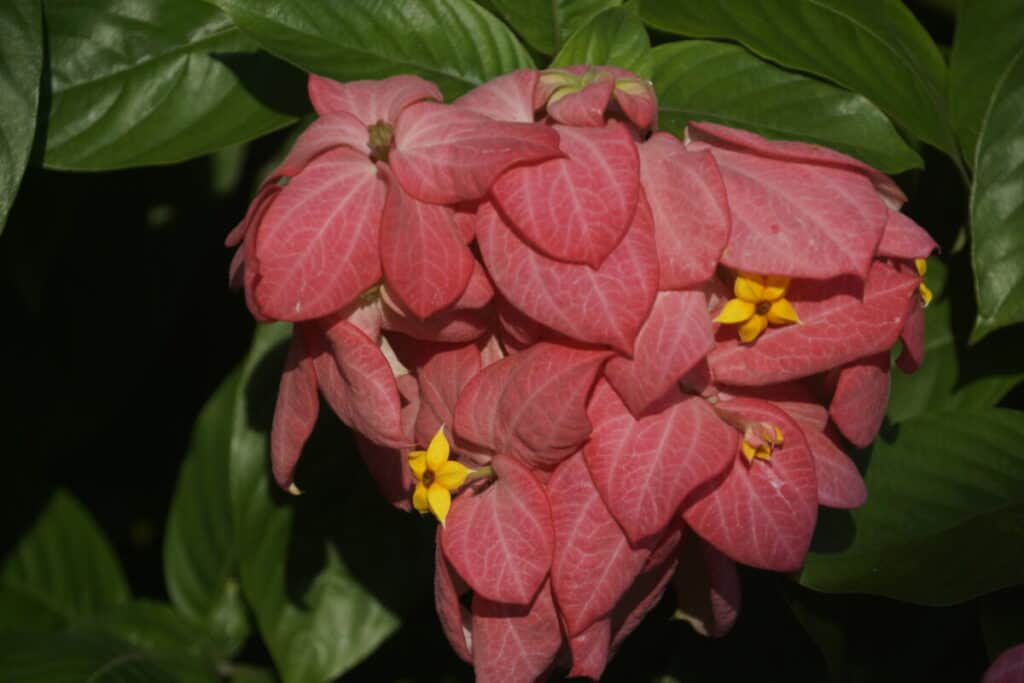The Weather Dictates Our Decisions
In any garden, it’s the weather, that dictates our big decisions! Our climate in winter is an easy-going version of the Northern Hemisphere’s warm summer.
But ah, our summer in the tropics is an exotic bird! Our latitude in Southwest Florida is 26.141 North. And our near neighbor is the Tropic of Cancer, the northern edge of the Equator. And it’s only about 3 degrees away!
Go to heaven
for the climate,
Hell for the company,
Mark Twain
Summer Arrives-With the Good News and the Bad
This is How the Weather Dictates Our Decisions
The tropical summer commences. The good news: we are surrounded by the lushest of exotic tropical blooms. They’ll be luxurious in the garden and the house for months. Here are some around us in the garden now.
Odontonema cuspidatum

This bush brings us huge magenta blooms and hummingbirds as a bonus. The tubular flowers each 3″ long, grow in long spikes on a bush that grows 4-6′ in height.
Easy to live with, it presents a bright space of color. Ours shades an understory garden of Hosta and Caladiums near a seating area overlooking the pond. It does require pruning.
A bonus is that the hummingbirds, usually fleeting in appearance, like to take their time drinking from these long champagne flutes!
Delonix regia

Like most places, we see trees in flowers during springtime. But in June we get both shade and drama from this tree. It is Delonix regia, you may also know it as the Royal Ponciana or flame tree. It blooms for us in vivid red or gold.
In June, we love its wide shade canopy and its late blooming period.
(When I italicize a plant name, I am showing you its Genus and species. If you want to buy one of the plants I am highlighting, using the botanical name will get you the right plant. For more information on plant, names read this. “Latin for Gardeners, How to Read and Remember Plant Names”
More Good News
We live in a resort town, suddenly gone quiet. Now we, the locals take back the town, no wait for a table in the restaurants and our 16 miles of beach are all ours!
Now, the Bad News
The hard part: The temperature rises, the humidity is high, and the rains begin! (Oh yes, it’s hurricane season.)
In 2022, NOAA is predicting an “above normal” hurricane season with an anticipated 14-21 storms of various sizes. They are not all for us, but we do believe in preparation. Here is how we prepare for hurricane season in our garden.
Check the statistics
- Our average high temperature-90 degrees F. Low is 74
- Our average rainfall this month is 8.86″
- Hours of Daylight 14
- Water temperature 86
- Hurricane season runs from June 1-November 30.
I’m a northern gardener with a sense of restraint. These tropical plants never cease to amaze me!
What’s in Bloom-What to Plant & What to Do
Every month these three elements are changing. Plants we loved 3 months ago need to be pruned back or even removed in the case of annuals. Below, I’ll cover how all three elements fit in the June Garden.
What’s in Bloom
The Powder Puff Plant-Calliandra haematocephala
The sparkly red flower at the beginning of this article, is our powder puff. It’s bud looks like a rasberry, you want to reach for it. It blooms in to the puff that blows in the breeze. We have coffee on the front porch and watch butterflies, hummingbirds and bees all around. Red is the most common but you can find some in pink and red too!

This is a special variety of hibiscus. It has a huge double bloom with deep pink and white inside it’s yellow ruffles. There are endless varieties of these repeat bloomers. You can try them in summer in containers if your winters are cold. Overwinter them in a cool shelter.
We bought three of these from a specialty breeder. One did not survive transplanting but the other two are glorious.
Handling the Weather-For the Garden and the Gardener
We have been Florida gardeners for a long time now, and here is one of the double best practices -best for both the garden and the gardener.
Become an Early Morning Gardener!
Everything goes better early in the morning before the heat sets in. Watering is most effective and less damaging to plants; the work is pleasant.
Check this post “Roots In June”: Summer Begins In The Garden”. It’s last year’s take on life in the garded. Every garden is different and each garden changes by the year. I hope you find something useful from each year.
Best Early Morning Chores
- Water-plants do best with early morning water and will dry before evening; this lowers the risk of insects and disease.
- Weed-in the morning, the soil is moist, and the roots come out easily.
- Cut flowers, harvest herbs, and vegetables, take cuttings for propagation-the stems are water filled and will last longer.
- Appy any fertilizers and pesticides-in morning the plants absorb the materials best.
- Plant, and Transplant-this reduces shock and allows the plants time to acclimate before heat comes.
- Fill the bird feeder, and the bird bath-birds are the classic early risers and you will enjoy their activities while you work.
- Do the heavy digging before it gets too hot-while you are most energetic do the hard work.
Effective Watering
“Water is the driving force of all nature”
–Leonardo da Vinci

The watering goal is to provide enough water, at the best time, without waste and without damaging the plants. Water is at the core of everything we grow and all year long. But summer is the most crucial time for water issues.
- Water early in the morning, before 9 in many climates; for us in the tropics, it’s before 8.
- Water deeply; it’s the roots that need the water-its where it all starts.
- Watch the plants with big leaves; they’ll show wilting first.
- Plants in containers require more frequent watering, often daily.
- Mulch to keep the water where you want it, in the ground.
For more detailed help with watering the garden read this: “Water The Garden, Not The Plants”
Sun Protection In The Garden
Plants grow in the sun; sunlight is what lets photosynthesis work! It’s sunlight that lets the plants create food from carbon dioxide and water. To be in the garden we enjoy the sun. But we might as well face it, skin cancer is the most common cancer in the world! Here are some ways to protect yourself from damage in the sun. “Sun Protection In The Garden”
Wildlife to See in Summer in South Florida
The Roseate Spoonbill

A prize to view on a summer day is the Roseate Spoonbill, a large bird (28-34′ long and with a wingspan of 47-52′). You won’t miss it!
The color is spectacular, a brilliant fuchsia body, red shoulders, accents of green and yellow, and a long bill used spoon-like to trench the soft earth and reveal tasty delights!
In the backyard pond we see herons, osprey, ibis and small terns with double neck rings. We are all ready for the rains to start!
We are in a tropical environment but still in North America! The climate is nothing like anywhere else in North America. It is actually more similar to The Philippines, Malaysia, or Brazil than even Atlanta!
Our winters are soft, and during them, we plant and harvest the same things that northern gardeners are watching for right now. Not us, those days of tomatoes and impatiens are gone. We won’t see them until fall, but new experiences await in this garden.
The Tiny Vegetable Garden
We have a small property into which we have put a lot of activities. Vegetables are tough to find a home for. Limited space and voracious wildlife have led to this little solution. Inside the screened lanai/swimming, lounging, dining area we squeezed this 12’x2′ elevated garden bed.
It has served the kitchen well this winter with a variety of foods and now should be passing it’s “sell-by” date!
This month it becomes a lesson in gardening when it’s hot.
The lettuce is gone but we are eating herbs, salads with nasturtums and some really remarkable sorrel!
If I had known how much we would have enjoyed having the sorrel greens for warm weather I would have planted more.
This acidic plant with bright leaves is a teriffic brightener of salad.

Herbs In The Summer Garden
In temperate climates, summer is the best time for herbs and they make a big impression on our meals. Tropical heat and humidity can make herb growing harder in our environment.
Here is my outline of culinary herbs for us all to grow. You can link inside it to more in-depth articles about individual herbs. These will provide my best detail on how to grow each plant and how to harvest it and use it in your cooking. Don’t overlook opportunities to use herbs. Use them fresh in meals and cook with them. Don’t overlook her
herb salt, simple syrup, butter as well as oil and vinegar.
This is a tropical version of the popular herb oregano. Try it if your humidity is a problem, if the rabbits are eating everything or if you love Caribbean or Southeast Asian Food.
Plumeria

If you have ever been given a scented lei on your arrival at your Hawaiian resort, you know this sweet tree,
Plumeria is native to the tropical Americas. Plant them in at least 6 hours of sun in well-drained, slightly acidic soil. Potted plants can be brought indoors during cold weather.
The flowers come in a considerable variety and are fragrant. If you visit Florida, you can see the National Collection of Plumeria at the Naples Botanical Garden.
In May I wrote a little about the tropical Mussaenda and Philippine Violets in bloom in our garden. They remain in bloom and are charming perennial l opportunities for many gardens.
Mussaenda

Mussaenda-Mussaenda philippica is a species in the Rubiaceae family. It can be grown as a shrub or a small tree. Keep it pruned, while the color is beautiful the form, unmanaged, can appear messy. They are native to the Philippines
The plants have romantic names like Donna Aurora, which is white. The varieties are named for the First Ladies of the Philippines.
Mussaenda, come in many colors, red, white, pink, peach, pale yellow. The flowers are small and tubular and appear in clusters. The blooms we admire, however, are the Sepals, not flowers. Sepals are actually the first layer of leaves and surround the flower. The Bougainvillea is another example of what we see are the Sepals which enclose tiny flowers.
For more information on this remarkable and lesser-known flowering shrub read this:
‘Mussaenda Plants: How to Grow the Luxuriant Tropical Dogwood.’
Philippine Violet
Philippine Violet-Barleria cristala is a shrub that is below 5′ in height and can be controlled by pruning. Its profuse tubular flower is violet in color. It has a broad oval leaf in a rich dark green.
Herbs In The June Garden
In robust health are Parsely, Dill, Basil, Rosemary, and a few others such as Mint for summer iced tea. Small Tomatoes and red peppers are profuse.
What Gets Done In June
Time To Plant Palms
Palms, in our environment, are planted throughout the year as needed. However, the best time to plant them is in the warm weather from spring to early fall. When the soil is warm, the roots begin their most active growth and establish themselves most quickly into the soil. The summer rains reduce the need for irrigation and the palms grow most quickly.
Planting
Plant the Palm tree by digging a hole allowing the palm to have its top at the soil level and about 1/3 larger than the root ball. Place the tree and fill the soil with soil that has not been amended and water well to remove any air pockets.
Cover with 2-3″ of organic mulch. Water daily for several weeks. Summer rains are common, but can be erratic. Remember to water on dry days.
Staking
Palms are trees that are often planted in mature sizes which permits us to create mature appearing landscapes in a few day’s time. Remarkable changes can be created this way. The risk is that our fast growing warm weather is also a stormy period with significant winds.
Staking the new trees provides some insurance against storm damage. 4 Wooden 2 x 4 stakes work well. Drive them into the ground. Protect the tree bark with a burlap section and tie the stakes around the tree. Do not drive any objects into the tree. Damage to the bark increases the risk of insect damage or disease.
Decisions on What to Plant and What to Do
Each month, we all face decisions about what to do in the garden. What we seem to have learned over the years is to get the best information you can find and the most local information you can find.
If you look at the what to plant and what to do charts I use each month you will notice a repetition of information from our state university in Florida. We also learn about our climate from other universities in the humid south where conditions are similar.
Locality is less important when it comes to techniques, and we know we can learn from any of the dedicated gardeners out there.
What To Plant in June
In May and June, we make large changes in plant material. Annual bedding plants change significantly. This list includes annuals we can use all summer. Annual herbs change too. We will grow no more cilantro and chervil until fall arrives.
Vegetables are the last big change. Communities around us grow most of the winter vegetables for the eastern US but we will miss local lettuce and tomato for the next few months.
| Category | Plants To Include | Resources |
| Annual Bedding Plants | These are limited by the humidity, use Portulaca, Vinca, Celosia and Some varieties of Coleus | https://edis.ifas.ufl.edu/mg319 |
| Palms | Palms can be planted in any month but summer is a particularly desirable time | Palms |
| Herbs | Rosemary, Basil, Parsely, Cuban Oregano | https://gardeningsolutions.ifas.ufl.edu/plants/edibles/vegetables/herbs.html |
| Vegetables | small Tomatoes, especially the native Everglades tomato, Sweet Potato | https://www.fairchildgarden.org/Events-Community-Outreach/Events-Details/wild-everglades-tomato-is-ideal-for-south-florida-gardens-1 |
| Shrubs | Shrubs can be planted in any month |
What To Do In The Garden
Pests and diseases are the focus of the tropical garden in summer. Being observant is the best thing we can do in the garden this season.
| Category | Tasks | Resources |
| Palms | seek out indications of pests and diseases | https://edis.ifas.ufl.edu/topic_palm_diseases |
| Pruning | This is the time for light pruning of summer flowering shrubs-this increases the booms | https://gardeningsolutions.ifas.ufl.edu/lawns/lawn-care/best-care-practices.html |
| Pests | This is prime pest season, monitor on a regular basis. | http://edis.ifas.ufl.edu/topic_landscape_pests |
| Irrigation | Rainy season does not mean regular rain. Observe water conditions. Test soil for moisture. Observe new plants, plants in full sun. | http://edis.ifas.ufl.edu/topic_landscape_irrigation |
| Solarizing Soil | If your vegetable garden is dormant consider soil solarization. | http://edis.ifas.ufl.edu/topic_soil_solarization |
| Summer Turf Care | The resource piece discusses best practices for lawn care. | https://gardeningsolutions.ifas.ufl.edu/lawns/lawn-care/best-care-practices.html |
| Fertilizer Rules | Does your local municipality have stricter fertilizer rules in warm/wet weather? | |
Summary, life in The South Florida Garden
For gardeners from temperate climates like us, South Florida has been a revelation. Upside down is a good analogy. Spring in November. Our impatiens are bright at Christmas, lilies for New Years!
Rain is not regular, its all or none. Soil is not soil, it’s sand and the water drains immediately. Bugs abound, we abut major tropical transportation hubs and new creatures, that we never contemplated show up each year.
Change keeps you on your toes, we are always learning something new. Gardeners, by nature are curious creatures and I hope this is entertaining to other gardeners.
Garden Pests To Watch For
In our climate, the pests never quit. We have them winter and summer, they are never not with us. If you garden in a temperate climate you forget the bugs for at least half the year but when summer comes it brings fruits, and flowers but always bugs. The tables below will give you some university research we rely on for our constant stream of hungry creatures.
Try also this article on pests from the Farmer’s Almanac, it might also help you.
